Anemia (anemia) is a common disease throughout the world. It can occur as an independent pathology or against the background of other changes in the body, also as a result of serious diseases.
In medicine, there is a certain classification of anemia by hemoglobin, each type is accompanied by characteristic clinical symptoms. For a diagnosis, a comprehensive examination and treatment is necessary to prevent serious complications.
Record content:
- 1 Causes of anemia
- 2 The norm of hemoglobin in the blood
- 3 Types of anemia
- 4 Classification of anemias
- 5 Symptoms of anemia depending on the level of hemoglobin
- 6 Diagnostics
- 7 The best iron supplements for anemia
- 8 Diet rules for anemia
- 9 Video about anemia
Causes of anemia
The pathological condition is characterized by a disturbed structure of blood cells, as a result of which the level of hemoglobin in the blood decreases.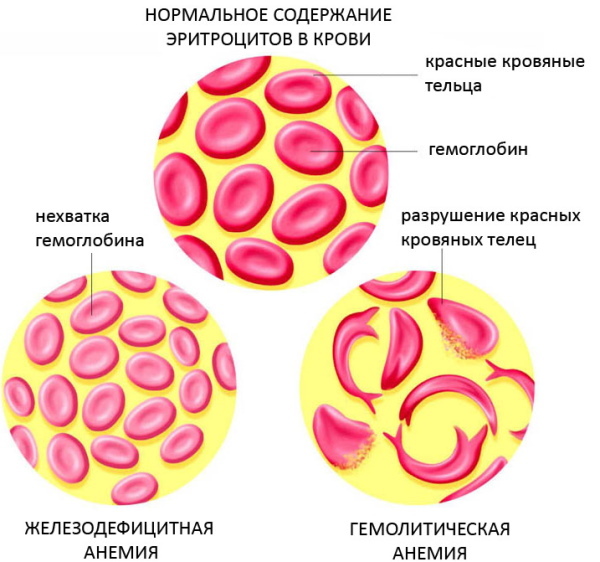
There are numerous provoking factors against which a person develops anemia:
- lack of vitamins and minerals in the human body;
- active growth of the child during pregnancy or breastfeeding, when the young body needs iron;
- diseases of the digestive system, which are accompanied by impaired absorption of nutrients;
- chronic bleeding;
- kidney and liver damage;
- malignant or benign processes;
- parasitic infection of the human body;
- hereditary factor;
- violation of blood clotting;
- viral diseases;
- body burn above 20%;
- severe intoxication of the body;
- endocrine system damage;
- great physical activity;
- prolonged stress and emotional stress;
- bad habits (abuse of alcoholic beverages, tobacco products).
Anemia is also caused by injuries and damage to the body, rheumatoid arthritis, and autoimmune disorders. In each individual situation, a person develops characteristic clinical symptoms that will help to suspect a pathology and go to the hospital in a timely manner.
The norm of hemoglobin in the blood
Indicators of hemoglobin in the blood and red blood cells fluctuate depending on the age of the person, from birth to old age.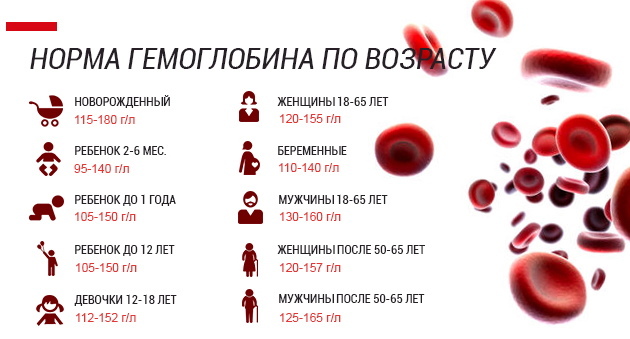
The parameters change during the period of gestation or during menopause:
| Gender | Indicators | |
| Hemoglobin (g / l) | Erythrocytes | |
| In men | 130-160 | 4-5,1 |
| Among women | 120-150 | 3,7-4,7 |
| Pregnancy | 110-150 | 3,5-4,2 |
| In children | 145-110 | 3,5/3,6-4,7/5,1 |
Minor deviations from the norm can be restored with proper nutrition and vitamin supplements. In difficult situations, with the appearance of characteristic clinical signs, a person will need medical attention.
Types of anemia
Anemia (classification by hemoglobin is determined by the doctor using a comprehensive diagnosis) occurs against the background of many provoking factors, as a result of which the level of hemoglobin in the blood changes.
In medicine, there are the following types of pathological conditions:
| Name | Description |
| Hypochromic anemia | In medicine, the disease is called hypochromia. Pathology is characterized by a decrease in the level of hemoglobin.
|
| Post-hemorrhagic anemia | The pathological condition occurs against the background of acute or chronic bleeding. |
| Folate deficiency anemia | Anemia results from low levels of vitamin B9, which is folic acid. |
| B12 deficiency anemia | The disease occurs against the background of an insufficient amount of vitamin B12 in the human body. |
| Hemolytic anemia | Anemia, which is characterized by the rapid destruction of red blood cells. Blood cells do not have time to be produced to replenish the balance. |
| Aplastic anemia | A disease in which the hematopoietic system is affected. The functioning of the bone marrow is impaired, which leads to insufficient production of blood cells (erythrocytes, leukocytes, platelets). |
| Sickle cell anemia | The pathological condition is characterized by the production of hemoglobin cells that have a defect.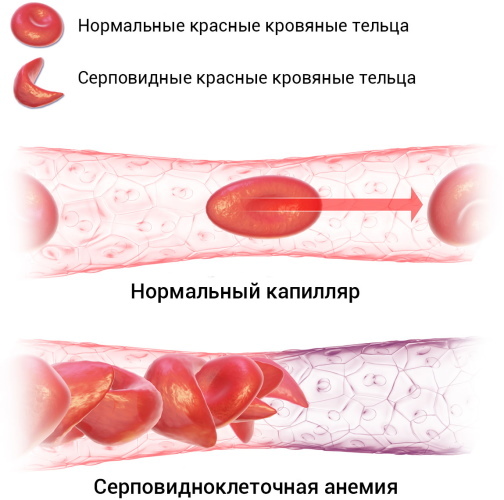
|
| Megaloblastic anemia | Anemia, in which there is insufficient production of red blood cells due to a deficiency of B vitamins in the human body. |
| Pernicious anemia | The pathological condition occurs as a result of a lack of vitamin B12. The bone marrow cannot produce enough blood cells. |
| Sideroblastic anemia | A rare form of anemia that occurs as a result of an excess of iron in a person's blood. For a specific reason, the bone marrow does not absorb this trace element. It accumulates in the blood and poisons the human body. |
| Fanconi anemia | A rare and hereditary disease characterized by serious changes in the human body. The process of hematopoiesis is disrupted, malignant tumors appear, various defects develop.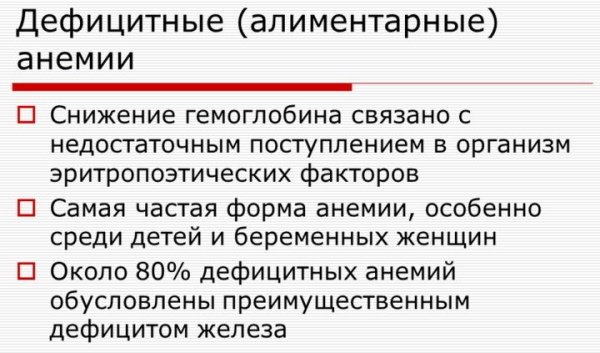
|
| Alimentary anemia | Anemia, which is characterized by low hemoglobin and iron levels as a result of poor diet. |
| Unspecified anemia | Disease of the hematopoietic system, against the background of which the functional qualities of the bone marrow are impaired. The end result is a suppression of the production of all blood cells. |
| Myelodysplastic syndrome | The disease is characterized by a severe course, with great difficulty in treating. Myelodysplastic syndrome (MDS) belongs to the group of hematological oncological pathologies. The disease disrupts the production of blood cells (development, division). |
| Refractory anemia with excess blasts | A form of anemia, in which the process of maturation of cells of the red sprout is disrupted. Acquired disease, accompanied by a violation of the quantitative and qualitative parameters of the blood. |
| Thalassemia | A disease that is more often inherited. Hemoglobin molecules are unstable due to insufficient maturation, resulting in anemia. |
| Diamond-Blackfen anemia | A hereditary form of anemia, which doctors have not fully studied. More common in children. The disease is characterized by low levels of hemoglobin and red blood cells. Indicators of leukocytes and platelets are unchanged.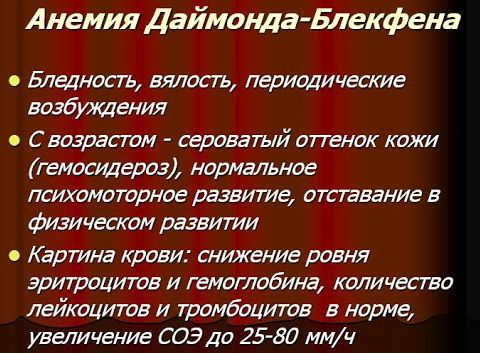
|
| Hemoglobinemia | The pathological condition provokes an increase in the level of free hemoglobin in the blood plasma. |
The types of anemia differ not only in provoking factors, but also in the clinical signs that accompany each form of the disease.
It is important to diagnose violations in a timely manner and carry out treatment in order to prevent possible complications.
Classification of anemias
The classification of anemia by hemoglobin in accordance with the established standards will allow the physician to identify violations and prescribe the patient the most informative examination. The results obtained are important not only for determining the exact cause of the pathological condition. The information is used during the preparation of the therapy regimen.
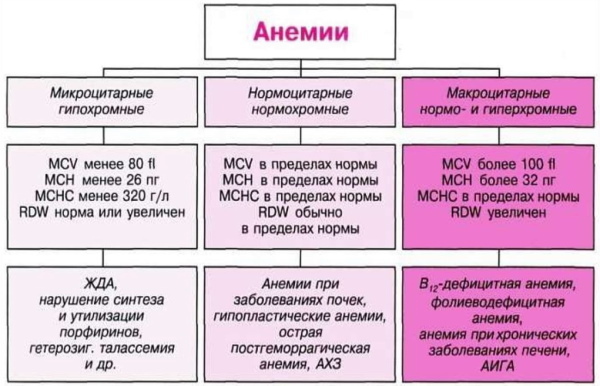
The classification of anemia is as follows:
| Name | Classification |
| By severity |
|
| By color indicator |
|
| By the ability of the bone marrow to regenerate |
|
| Pathogenetic classification |
|
| By etiology |
|
Anemia (classification by hemoglobin will allow the doctor to establish an accurate diagnosis) often occurs against the background of other pathological processes.
Therefore, it is important to timely establish the underlying cause and start treatment in order to prevent possible consequences.
Symptoms of anemia depending on the level of hemoglobin
The clinical picture with the onset of anemia will help the doctor determine the severity of the pathological condition.. Patient complaints are also taken into account when drawing up a treatment regimen.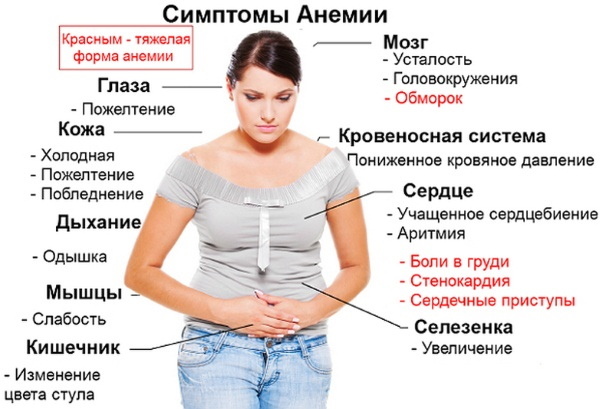
Symptoms of anemia, depending on the degree of impairment:
| Name | Symptoms |
| Mild degree |
|
| Average |
|
| Severe stage |
|
In difficult situations, a properly selected therapy is needed after a comprehensive diagnosis. Progressive anemia provokes serious complications, including death.
Diagnostics
An examination is prescribed to the patient in order to establish an accurate diagnosis and the cause of the decrease in hemoglobin levels.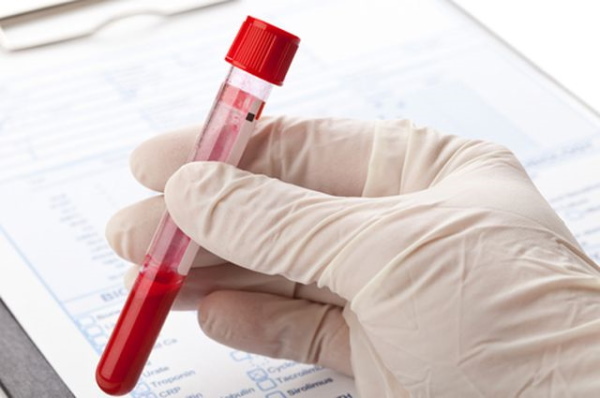
Patients are assigned the following diagnostic methods:
| Name | Description |
| General blood analysis | The results of the study will help determine the level of leukocytes, erythrocytes, hemoglobin and evaluate other characteristics of blood cells. |
| Blood chemistry | The data obtained will help to identify changes in the concentration of iron, vitamins and trace elements in the blood. |
| Colonoscopy | An informative diagnostic method, during which specialists carefully study the large intestine, its walls and lumen. |
| Gastroscopy | The examination will reveal pathological processes in the gastrointestinal tract. |
| General urine analysis | The test results allow you to assess the functioning of the urinary system. |
| Computed tomography (CT) | The most diagnostic method, with the help of which specialists carefully and layer by layer look through the internal organs, with high accuracy determine the area of localization of the pathological focus and identify concomitant diseases. |
Comprehensive diagnostics will allow you to differentiate anemia and establish the exact type of disease, as well as determine the provoking factor.
The best iron supplements for anemia
Anemia (classification by hemoglobin is established through a comprehensive examination) is treated with complex methods. Patients are prescribed specially selected medications, it is necessary to adhere to proper nutrition. In the absence of serious contraindications, folk remedies can be added to traditional methods.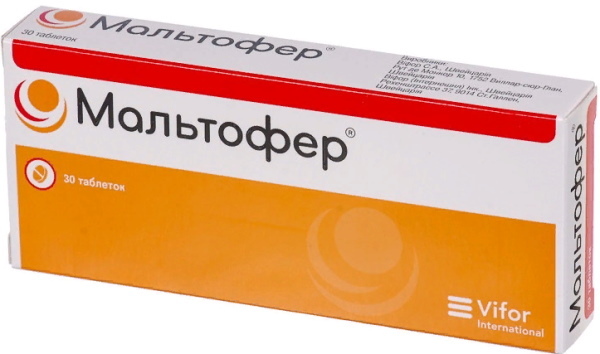
Medicines will help restore not only the level of hemoglobin, but also iron, the process of producing red blood cells:
| Name | Application | Contraindications |
| Piracetam | Patients are prescribed 30-160 mg / kg per day, depending on the severity of the anemia. The daily dosage is divided into 4 doses. The course of treatment lasts 2 months. |
|
| Maltofer | The medicine should be taken 1-3 tablets per day. The dosage depends on the degree of development of the anemia. The average duration of treatment is 3-5 months. The tablets can be chewed or swallowed whole with a little water. |
|
| Folic acid | Adult patients are prescribed 5 mg per day. The duration of therapy is 20-30 days. |
|
In the event of acute or chronic bleeding, surgery is indicated for patients. The same applies to tumor neoplasms, bleeding polyps. In difficult situations, a bone marrow transplant or blood transfusion (plasmapheresis) is performed.
Diet rules for anemia
A properly formulated diet is an integral part of therapy for anemia.. It is necessary not only to follow a diet, but also to remember the useful recommendations of a nutritionist doctor.
| Allowed Products | Prohibited foods |
|
|
Prohibited foods do not have to be strictly excluded from the diet, it is important to reduce their consumption. It is necessary to compose the menu in such a way as to not only replenish iron stores, but also other vitamins and microelements. They help this element to be absorbed.
Anemia belongs to the category of diseases commonly diagnosed in children and adults.
In most cases, anemia occurs against the background of the development of pathological processes. Rarely appears as an independent violation. Hemoglobin classification will help determine the type of disease and choose the most effective treatment.
Video about anemia
Anemia - symptoms, causes:


